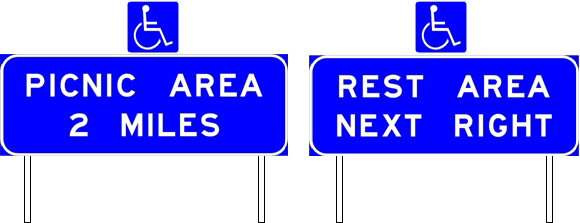Section 24: Accessibility Signing for Rest and Picnic Areas
Anchor: #i1010828Introduction
Many of the rest and picnic areas throughout the state have been modified to meet the requirements of the Americans with Disabilities Act (ADA). The signs described in this section are intended to better inform the public of the Texas Department of Transportation’s (TxDOT’s) continuing effort to provide accessibility at all facilities.
Anchor: #i1010838Use of the Accessibility Plaque
Divided Highways and Freeways. Rest and picnic areas on divided highways and freeways that have been modified to meet ADA requirements should be signed with the D9-6 accessibility plaque as illustrated in Figure 7-17. The D9-6 accessibility plaque should be attached to the parent sign, not to the parent sign supports (see Figure 7-17). The preferred position is above the parent sign, but if it is mounted below, a 7-foot minimum clearance between the bottom of the plaque and the edge of the pavement surface must be maintained.
Figure 7-18. ADA Accessibility plaques (D9-6) attached to advance picnic and rest area signs for divided highways and freeways
Conventional Roadways. Rest and picnic areas on conventional roadways that have been modified to meet ADA requirements should be signed with the D9-6a accessibility plaque, indicating that the facility provides ADA accessibility to one or more picnic areas. The D9-6a accessibility plaque may be attached above or below existing advance and directional REST AREA and PICNIC AREA ( D5 series) signs or incorporated as a standard design for new signs (Figure 7‑18). If the plaque is mounted below the parent sign, a 7-foot minimum clearance between the bottom of the plaque and the edge of the pavement surface must be maintained.
Figure 7-19. Advance and directional rest area signs (D5 series) for conventional highways showing ADA accessible message
Anchor: #i1010876Historic Picnic Areas
Thirty-eight picnic areas around the state will not be modified to fully meet ADA standards due to their historic significance. To notify the public of the historic significance of these picnic areas and the reasons they are not fully ADA accessible, the HISTORIC ROADSIDE PARK sign (D7-10b) should be used at these sites. (See Standard Highway Sign Designs for Texas for sign details.) The sign is shaped to resemble a 1930s Texas Highway Department ROADSIDE PARK sign. In addition to a unique message explaining the site’s historical significance, the sign contains the following explanation:
“In order to preserve its historic character and significance, this picnic area may not be fully accessible under the normal standards for public facilities set forth in the 1990 Americans With Disabilities Act.”
The sign should be erected within the picnic area, and is not intended to be visible from the roadway.
A listing of the historic picnic areas may be obtained from the TxDOT Traffic Operations Division (TRF).

